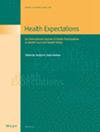Towards a New Integrated Model for Taking Into Account the Experiential Knowledge of People With Chronic Diseases, Integrating Mediation, Therapeutic Education and Partnership: The Expanded Chronic Care Patient–Professional Partnership Model
Abstract
Introduction
The Chronic Care Model (CCM), the Expanded Chronic Care Model (ECCM) and the eHealth Enhanced Chronic Care Model (eCCM) focus on how healthcare teams and eHealth support can offer effective care and relevant solutions for patients facing chronic care conditions. However, they do not consider how patients can help these teams in their work, nor do they promote ways in which patients can help themselves. However, in the last decade, three different models have emerged that can complete our capacity to design and deliver integrated care for people with chronic diseases. In this article, we propose a revised version of the model that integrates the patient perspective and patients' experience-based knowledge. It integrates three different ways of engaging patients that complement the other patient engagement point of view: the experience of care and mediation in healthcare, therapeutic patient education and patient learning pathways, as well as patient–professional partnership.
Methodology
For each of the three models, we conducted a review of the literature using CINAHL, Medline, OVID, EMBASE PsychINFO, Science Direct and government reports on patient engagement and partnership with their healthcare providers, to integrate the different components of these models into the ECCM and eCCM. The goal is to create a model that better takes into account the experiential knowledge of patients and citizens throughout its different dimensions.
Results
We identified 129 papers based on their framework, design, sample, measures and fit with patient engagement and chronic illness and added our own research when relevant. Integrating the three models provides an opportunity to amplify the role played by the patient perspective in the management of chronic disease. The Expanded Chronic Care Patient–Professional Partnership Model (E2C3PM) is intended to rebalance power relations between healthcare professionals and patients (and their caregivers). This new model is based on recognizing patients' experiential knowledge and their roles as caregivers and as full members of the care team. Integrating patient empowerment into the E2C3PM underscores the importance of coproduction care with patients at the clinical, organizational and system levels within a supportive environment.
Conclusion
Applying this new model should make it possible to better take into account the complexity of chronic diseases, improving the integration not only of care, services and eHealth support but also the various determinants of health and reaching a mutually beneficial settlement among all actors involved.
Patient or Public Contribution
A patient-researcher contributed to the development of the protocol, the data collection and the preparation and writing of this manuscript.


 求助内容:
求助内容: 应助结果提醒方式:
应助结果提醒方式:


